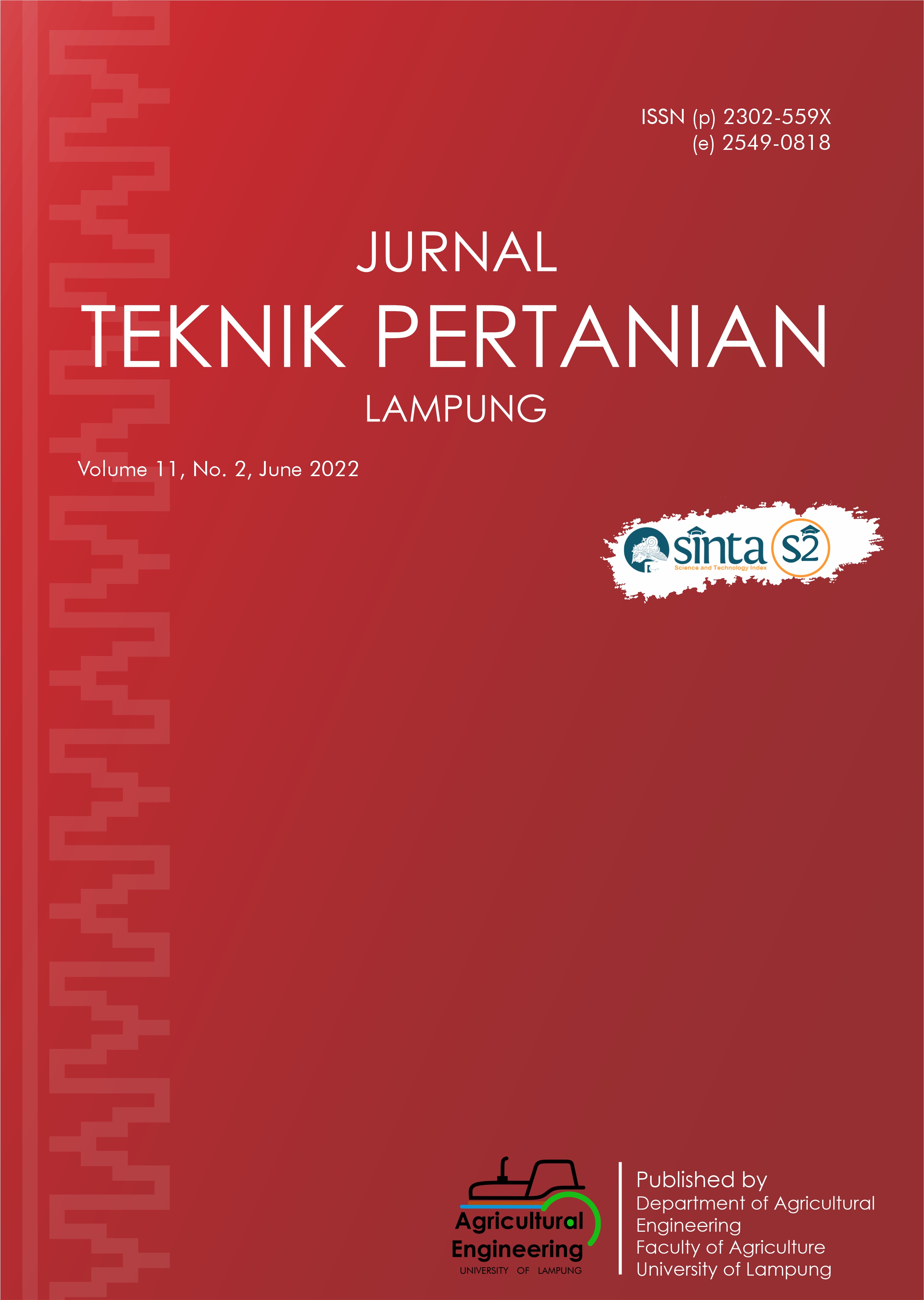Power Tiller Requirement for Cassava Cultivation at Estate Scale
DOI:
https://doi.org/10.23960/jtep-l.v11i2.292-303Abstract
Indonesia's food needs continue to increase along with population growth. Land development for supporting the cassava food estate is one of the priority programs of the central and regional governments. The purpose of this study was aimed at determining the need for power tiller for land management based on land area. This research was carried out at the planned location of the cassava plantation in Gunung Mas Regency, Central Kalimantan in 2020. The data on the land area planned was determined from a topographic map, while the tractor needs were obtained from the calculation of field capacity. The area of land suitable for cassava cultivation is 1227.57 ha which is divided into 25 blocks. The basis for the number of tractors as power tiller needed is determined from the time of tillage work so that it requires working capacity variables, including data on land area, work speed, and width of the plow implement. The plow studied in this study used 2, 3, 4, and 5 blades of disc plows. The need for a tractor with a 5-blade disc plow is 2 tractors that work fully and take turns cultivating an area of 1227.57 ha in the span of one cassava cultivation period (7-8 months). If the disc plow used is less than five blades, it will affect the working width of tillage, so the work time will be longer and the need for power tiller will increase.
Keywords: Cassava, Disk Plow, Food Estate, Power Tiller, Tractor
References
Ali, A.M. (2018). Study the impact of plow and harrow type on some technical-economical indicators of the machinery unit. Int. J. Agricult. Stat. Sci. Vol, 14(1), 293–298.
ASABE. 2013. ASABE S414.2 Standard: Terminology and definitions for agricultural tillage implements. Michigan USA: American Society of Agricultural and Biological Engineers.
BSN. 2013. SNI 7416:2013: Traktor pertanian roda empat gandar ganda – Syarat mutu dan metode uji. Jakarta: Badan Standarisasi Nasional.
Bulgakov, V., Pascuzzi, S., Ivanovs, S., & Volskyi, V. (2019). Experimental investigations in draft resistance of spherical working tool of disk harrow. Proceedings of the 18th International Scientific Conference "Engineering for Rural Development", Jelgava, Latvia, 22-24 May 2019, 144–152.
Godfray, H.C.J., Beddington, J.R., Crute, I. R., Haddad, L., Lawrence, D., Muir, J.F., Pretty, J., Robinson, S., Thomas, S.M., & Toulmin, C. (2010). Food security: The challenge of feeding 9 billion people. Science, 327(5967), 812–818. https://doi.org/10.1126/science.1185383
Gottlieb, R., & Joshi, A. (2010). Food Justice. Mit Press.
Hanif, I.A., Sutan, S.M., & Nugroho, W.A. 2015. Uji implemen bajak piring (disc plow) untuk pengolahan tanah dengan menggunakan traktor John Deere 6110 B dengan daya 117/2100 HP. Jurnal Keteknikan Pertanian Tropis dan Biosistem, 3(3), 372-381.
Kogan, F. (2019). Remote Sensing for Food Security. Springer Cham, Switzerland. https://doi.org/10.1007/978-3-319-96256-6
Lasminingrat, L., & Efriza, E. (2020). The development if national food estate: The indonesian food crisis anticipation strategy. Jurnal Pertahanan & Bela Negara, 10(3), 229–248. http://dx.doi.org/10.33172/jpbh.v10i3.1110
Ma’ruf, A.Z., Zulia, C., & Safruddin, S. (2017). Rice estate development as state owned enterprises (SOEs) to self-supporting for food. European Academic Research, 4(12).
Saraswati, R., & Husen, E. (2007). Prospek penggunaan pupuk hayati pada sawah bukaan baru. In Lahan Sawah Bukaan Baru (Agus, F. (Ed.). Pusat Penelitian dan Pengembangan Tanah dan Agroklimat, Bogor, 151–173.
Slepenkov, A. E., Polikutina, E. S., Shchitov, S. V, Kuznetsov, E. E., & Krivutsa, Z. F. (2021). Increasing the efficiency of use of wheeled harrow units in regions of risk farming. E3S Web of Conferences, 262, 1003. https://doi.org/10.1051/e3sconf/202126201003
Wargiono, J. (1979). Ubi kayu dan Cara Bercocok Tanam. Lembaga Pusat Penelitian Pertanian, Bogor, 36 pp.
Wargiono, J., & Hasanuddin, A. (2006). Teknologi Produksi Ubi kayu Mendukung Industri Bioetanol. Badan Penelitian Dan Pengembangan Pertanian, Jakarta, 42 pp.
Wulandani, B. R. D., & Anggraini, W. (2020). Food estate sebagai ketahanan pangan di tengah pandemi Covid-19 di Desa Wanasaba. SELAPARANG Jurnal Pengabdian Masyarakat Berkemajuan, 4(1), 386–390. https://doi.org/10.31764/jpmb.v4i1.3062
Yadav, A., & Ghosh, S. (2019). Forecasting monthly farm tractor demand for India using MSARIMA and ARMAX models. Indian Journal of Agricultural Research, 53(3), 315–320. https://doi.org/10.18805/IJARe.A-5185
Yestati, A., & Noor, R. S. (2021). Food estate dan perlindungan terhadap hak-hak masyarakat di Kalimantan Tengah. MORALITY: Jurnal Ilmu Hukum, 7(1), 52–73. http://dx.doi.org/10.52947/morality.v7i1.190
Zakky, M., Pitoyo, J., & Prayoga, A. (2021). Unjuk kerja mesin pemanen padi (Oryza sativa) kombinasi mini (mini combine harvester). Jurnal Teknik Pertanian Lampung, 10(3), 303–308. http://dx.doi.org/10.23960/jtep-l.v10i3.303-308
Downloads
Published
Issue
Section
License
- Authors who publish with this journal agree to the following terms:
- Authors retain copyright and grant the journal right of first publication with the work simultaneously licensed under a Creative Commons Attribution-ShareAlike 4.0 International Lice that allows others to share the work with an acknowledgement of the work's authorship and initial publication in this journal.
- Authors are able to enter into separate, additional contractual arrangements for the non-exclusive distribution of the journal's published version of the work (e.g., post it to an institutional repository or publish it in a book), with an acknowledgement of its initial publication in this journal.
- Authors are permitted and encouraged to post their work online (e.g., in institutional repositories or on their website) prior to and during the submission process, as it can lead to productive exchanges, as well as earlier and greater citation of published work (See The Effect of Open Access).
Jurnal Teknik Pertanian Lampung

JTEPL is licensed under a Creative Commons Attribution-ShareAlike 4.0 International License.

